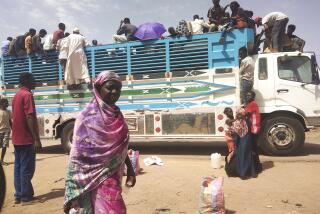World Vision Helps Restore Life to Famine-Struck Ethiopian Dust Bowl
- Share via
Five years ago, Mohammed Said abandoned his barren farm and made the three-hour trip by foot to the relief center in Ethiopia’s Ansokia Valley.
The famine that was ravaging the country had claimed the lives of his child, his mother and his father-in-law. And it almost claimed his. Said had to be fed for six months before he could muster the strength to leave the camp, with a dairy cow and a loom, given to him by relief center workers to start his life anew.
Today Said, 45, weaves for a living and has four children, two supported by a program sponsored by Monrovia-based World Vision.
Streams are flowing in the valley again, and cattle graze on lush grass. Nearly 6 million young trees planted after the height of the famine are now thriving. The 34,000 villagers in Ansokia consider themselves more prosperous today than they have been in 30 years.
It is a miraculous turnaround for an area that five years ago was a dust bowl; in the area near the relief site, as many as 15 people were dying of hunger each day.
“Ansokia is one of our best efforts,” said Bruce Brander of World Vision, the relief organization assigned to the drought-stricken valley 250 miles north of Addis Ababa.
The Arcadia resident recently visited the region’s 17 villages to document their progress on the fifth anniversary of the famine. The final death toll in the country exceeded 1 million, Brander said.
“Right now the valley is green from end to end,” said Brander, crediting irrigation and reforestation efforts as well as the return of the rains for the transformation. The inhabitants are rejoicing that leopards, which started disappearing decades ago as the villagers denuded the land of trees for fuel, have returned, signifying the success of the replanting.
Now that the crisis of saving lives is past, development work is under way to “famine-proof” the 35-mile-long valley dotted with thatched homes of mud and stone, Brander said.
Terraces with water catchment areas have been created for farming, stone reservoirs have been built and wells are being drilled. The villagers previously relied on streams for their water, Brander said. The work paid off when the valley survived a drought in 1988, remaining green and fertile.
The region’s first high school is being built. Sanitation is taught with songs: a hand-washing song, a diarrhea song.
In the last year, World Vision has distributed $731,310 in international aid in Ansokia alone, Brander said. Some 7,135 children in the valley are provided with daily necessities, medical care and an education through the sponsorship program.
Only eight World Vision consultants, native specialists in agriculture or medicine, remain in Ansokia, and they plan to withdraw as the villagers get back on their feet. As one farmer told Brander: “We’re looking to the day when the donor can leave.”
For Brander, who returned from Ethiopia in August, traipsing around the globe has become almost routine. Within the last year, the former journalist and one-time National Geographic Society photographer has recorded World Vision rescue efforts from the Armenia earthquake to the Bangladesh flood.
Capturing a revitalized Ansokia on film was a relatively cheerful assignment.
“Photographing the people was a treat,” he said. “They and their activities were just eminently pictorial. They’re very, very handsome.” A far cry from the haggard faces and bony frames that haunted feeding camps just five years ago.
“The big question on everybody’s minds has been: ‘Is all that money poured in today to save people who would die tomorrow?’ It seems that bloated bellies and dying children attract donors to help, but we’d like to get in there and prevent that,” Brander said.
More to Read
Sign up for Essential California
The most important California stories and recommendations in your inbox every morning.
You may occasionally receive promotional content from the Los Angeles Times.













